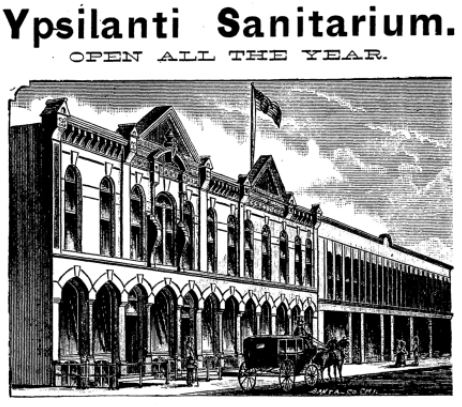
YpsilantiHotelSpaBuildingCompanyThing
The Ypsilanti Sanitarium was established in 1883 and opened January 10, 1884. The enterprise was initiated by either George P. Elliott or William P. Elliot—sources consistently fail to be specific about who this "Elliot" was, but research has limited the choices to these two. Elliot solicited investment from businessmen within Ypsilanti, in particular Horace E. Shutts, for a rehabilitation ("cleansing and repacking") of the George Moorman mineral water well [other accounts call this "Cornwell's well"] located in the first block of the east side of North Huron Street. The sanitarium was constructed in conjunction with George Moorman's Occidental Hotel where clients of the sanitarium stayed.
The following is a synopsis of the Sanitarium's advertisement of 1891.
"Elliott & Shutts," ''Portrait and biographical album of Washtenaw County... (Chicago: Biographical publishing co., 1891), 269.
The Sanitarium comprises forty large, well-ventilated bathrooms, with elegant parlors for ladies and gentlemen, smoking and reading rooms and all modern conveniences. The entire building is heated by steam and each room is connected with the office by electric bells.
See also
Horace E. Shutts
The Sanitarium was connected to the Occidental Hotel which was owned and operated by George Moorman & Cornelius Cornwell. The sanitarium was managed by Morris Hale?, M.D.
According to its advertisement, the Ypsilanti Sanitarium was "pleasantly situated on the west bank of the Huron River..."
"The design of this Institution is to give the health seeker all the advantages for restoration to health known to the medical profession and specialists being the only Mineral Water Sanitarium possessing as it does many new appliances and remedial agents of great curative value not found elsewhere in this country or Europe for the treatment of Acute and Chronic Diseases with their varied complications"
Typical of "remedies" and "cures" of the day, the Sanitarium advertised that its methods would lead "to the successful treatment of ... mental derangements from over brain work or excitement exhaustion, prostration, anæmia, hyperæmia, congestion, hallucinations, insanity, ... spinal anæmia, congestion, irritation, curvature and congestion, anæmia and irritation of the sympathetic nerve centers along each side of the spine and base of the brain, neuralgia, St. Vitus dance, hysteria, lumbago, sciatica, ... diseases of the heart, lungs, liver, stomach, and kidneys, ... cancer [which the sanitarium identified as a "blood poison"], syphilis, ... Rheumatism, ... debility following typhoid and other forms of fever, fever sores, abcesses, ulcers, burns, mineral, vegetable, and insect poisoning, catarrh, piles, ... lupus, [and] eczema."
Additionally, all these diseases were treatable "in their varied complicated forms together with diseases peculiar to each sex."
The building had steam heat, an elevator for the accommodation of "wheeled chairs," and electric bells for calling the staff.
In all, the sanitarium offered "accommodations excellent, cures wonderful, charges moderate, and the table bountifully supplied."
"Elliot & Shutts?," Portrait and biographical album of Washtenaw County, Michigan, containing biographical sketches of prominent and representative citizens, together with biographies of all the governors of the state, and of the presidents of the United States (Chicago: Biographical Publishing Co., 1891), 269.
It is not yet clear from the sources when Elliot left the partnership (or died), but Horace Shutts was in control of the combined Occidental Hotel & Bathhouse by 1904. Shutts had married the daughter of the Occidental Hotel's founder George Moorman. The hotel was constructed by the Moorman-Cornwell partnership and in their control as late as 1891.
In 1886, while drilling for a new well, they struck natural gas:
Ypsilanti Will Try For Natural Gas. Ypsilanti, February 13. Prospects are very favorable for Ypsilanti to keep up in the procession with other cities and have her turn in striking natural gas and the consequential excitement. About three years ago it became necessary for the proprietors of tho Ypsilanti Sanitarium to sink a second well in the rear of their building on Huron street, and in so doing a small vein of natural gas was struck at a distance of about 375 feet below the surface. When a match was applied a good-sized flame resulted, but the object being to obtain mineral water, the vein was shut off by the casing used in constructing the well and nothing more thought of the matter. Workmen recently employed in cleaning and repairing the well noticed the smell of gas and, applying a light, were surprised to see a flame shoot about five feet into the air gradually subsiding until it gave a steady light one foot high. When the pump is in motion this flame will blaze-up six-feet. A pipe will be laid to the boiler of-the engine in the sanitarium and they will utilize the gas in helping to make steam. There is talk of forming a stock company for the purpose of drilling for the much sought for article.
Detroit Free Press, February 14, 1889, p. 4.
Pictures of the exterior & Dining room. https://quod.lib.umich.edu/m/micounty?didno=3132587.0001.001;rgn=full+text;size=25;sort=occur;start=1;subview=detail;type=simple;view=reslist;q1=Occidental+Hotel
Ann Arbor City and Washtenaw County Directory for 1886-1887, vol. II (Detroit: R. L. Polk & Co., 1886), p. 5.
Citation: When referencing this page please use the following citation:
Unless otherwise noted all content on the Michigan Transportation History site is Copyright © 2020.
Page last modified on October 26, 2020, at 11:43 AM EST